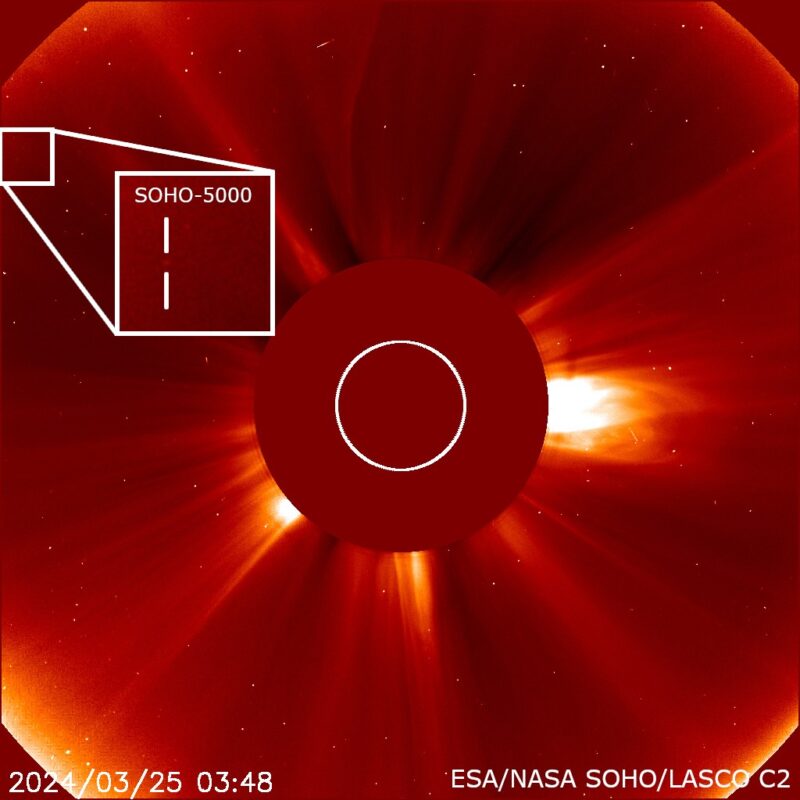- NASA’s sun-observing SOHO spacecraft has now made its 5,000th comet discovery. As of March 29, 2024, it has been 28 years, 3 months, and 27 days since SOHO launched in December, 1995!
- These comets are sungrazers. Sungrazing comets are those that pass extremely close to the sun at their closest point (perihelion), sometimes within a few thousand kilometers of the sun’s surface. Some are vaporized, but some survive to pass near the sun again and again.
- SOHO’s comets were found with the help of citizen scientists as part of the Sungrazer Project.
Vanessa Thomas originally wrote this story, which NASA published on March 27, 2024. Edits by EarthSky.
SOHO discovers its 5000th comet
On March 25, 2024, a citizen scientist in the Czech Republic spotted a comet in an image from the Solar and Heliospheric Observatory (SOHO) spacecraft. It’s now confirmed as the 5,000th comet discovered using SOHO data. SOHO has achieved this milestone over 28 years in space, even though it was never designed to be a comet hunter.
The newest comet is a small body of ice and rock that orbits the sun every few years. It belongs to the “Marsden group” of comets. Experts believe this group is related to Comet 96P/Machholz. That comet is named for Don Machholz, who was a beloved member of the EarthSky team until his passing in 2022. Don discovered 12 comets that bear his name. SOHO observes Comet 96P/Machholz every 5.3 years when it passes near the sun.
The Marsden group is named for the late scientist Brian Marsden, who first recognized the group using SOHO observations. Only about 75 of the 5,000 comets discovered with SOHO belong to the Marsden group.
Join us in our mission to educate and inspire people about the universe. Your donation can make a difference in astronomy and contribute to our growth and sustainability.
The most prolific comet-finder in history
A joint mission of ESA and NASA, SOHO launched in December 1995 to study the sun and the dynamics in its outer atmosphere, or the corona. A science instrument on SOHO – the Large Angle and Spectrometric Coronagraph (LASCO) – uses an artificial disk to block the blinding light of the sun. This masking allows scientists to study the corona and environment immediately around the sun.
It also allows SOHO to do something many other spacecraft cannot: see comets flying close to the sun, known as “sungrazing” comets or “sungrazers.” Many of these comets only brighten when they’re too close to the sun for other observatories to see. Therefore, they would otherwise go undetected, lost in the bright glare of our star.
While scientists expected SOHO to serendipitously find some comets during its mission, the spacecraft’s ability to spot them has made it the most prolific comet-finder in history. SOHO has discovered more than half of the comets known today.

Sungrazer Project
Soon after SOHO launched, people around the world began spotting so many comets in its images that mission scientists needed a way to keep track of them all. In the early 2000s, they launched the NASA-funded Sungrazer Project, which allows anyone to report comets they find in SOHO images.
SOHO’s 5,000th comet was found by Hanjie Tan, a Sungrazer Project participant who is originally from Guangzhou, China. He’s currently pursuing a doctoral degree in astronomy in Prague, Czech Republic. Tan has been participating in the Sungrazer Project since he was 13 years old and is one of the project’s youngest comet discoverers. Tan said:
Since 2009, I’ve discovered over 200 comets. I got into the Sungrazer Project because I love looking for comets. It’s really exciting to be the first to see comets get bright near the sun after they’ve been traveling through space for thousands of years.
Most of the 5,000 comets discovered using SOHO have been found with the help of an international cadre of volunteer comet hunters in the Sungrazer Project. And many of them have no formal scientific training.
5000th comet wows scientists
Karl Battams is a space scientist at the U.S. Naval Research Lab in Washington, D.C., and the principal investigator for the Sungrazer Project. He said:
Prior to the launch of the SOHO mission and the Sungrazer Project, there were only a couple dozen sungrazing comets on record: That’s all we knew existed. The fact that we’ve finally reached this milestone – 5,000 comets – is just unbelievable to me.
The vast number of comets discovered using SOHO has allowed scientists to learn more about sungrazing comets and groups of comets that orbit the sun. Comets discovered by the Sungrazer Project have also helped scientists learn more about the sun, by watching the comets plunge through our star’s atmosphere like small solar probes. Battams said:
The statistics of 5,000 comets, and looking at their orbits and trajectories through space, is a super unique dataset. It’s really valuable science. It’s a testament to the countless hours the project participants have put into this. We absolutely would never had reached this milestone if it wasn’t for what the project volunteers have done.
Bottom line: Citizen scientists using imagery from the SOHO solar observatory have now discovered their 5000th comet. You can help, too! Join the Sungrazer Project.
Via NASA